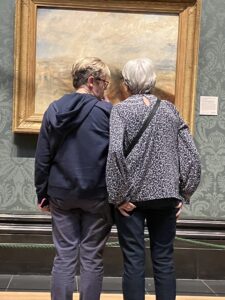There. I said it. I hate museums. I just didn’t know until now that I hated them. It took understanding why you might want to hate them for me to acknowledge the aversion.
I don’t always hate museums, and there’s always something to do in a museum. For instance, you can go to the café on the ground floor, or in the annex, or somewhere else, which is always very pretty and inviting, stand in line, mess up the coffee machine, eat bad cheesecake, get in a fight with the staff because they served you a cold sandwich that was supposed to be hot … Just kidding. Museums are wonderful places, of course. Especially art museums. There is usually a LOT of art. Sometimes, museums only display very few works. That makes them easier to take in. If there’s a lot, it can be overwhelming, which is usually the case. There is usually a lot of white or other plain colors. In the new museum at the former Tacheles in Berlin Mitte (Oranienburger Straße) there is a lot of graffiti in the hallways, and the background to the images on display is grey. Kind of dark. There are always things to read next to the artwork, so you know what you are looking at. Clearly, art cannot be trusted to speak for itself. Come to think of it, the whole thing is more like a zoo for artwork. Makes one wonder whether the art on display was trapped, tranquilized, and taken in boxes to a safe and protected space (“Don’t touch the artwork!”) where it can do no harm, while still entertaining the visitors and their children. Perhaps someone should do a comparative study on art-museum and zoo education and how they have changed over time. Animals are no longer supposed to be confined in inhumane ways. Perhaps artwork will be next? Let it roam free, liberated from explanatory labels, grey or white walls, and far from the uncomprehending gaze of the unwashed. Or the washed, for that matter.
And the poor guards? Imagine spending a whole day standing around or walking on marble along a confined and preordained route, much like the panther in Rilke’s poem, in standard issue shoes, not really looking at the art at all, but making sure that people behave. Kind of like a zookeeper. It does not seem to be a fun thing to do with one’s life. Miriam always talks to some of the museum guards, and she’s long thought it would be great to do an art piece on museum guards. Would that need to be guarded, too? What she means is this: if we only look at the artwork and ignore the people that are there to make sure the art on display is safe from curious touchers, tomato-juice-armed environmentalists, and random vandalists, there is something wrong with that picture.
Which brings me to something I read that made me think it’s ok to hate museums. In Hannah Arendt’s Men in Dark Times, there’s a particularly dense chapter on Hermann Broch. I knew the name and thought of him as a novelist, which he was, but he was also someone keenly interested in science, and he developed a theory of knowledge that reached for some kind of “earthly absolute.” (I spare you the details, mostly because I am not sure I understood them myself.) What I learned from that essay is that Broch harbored profound contempt for the idea of l’art pour l’art, that is, turning the aesthetic experience into an absolute value among other absolute values. In the extreme case, to think of art as an absolute value can lead, as Arendt remarks, to an appreciation of the beauty in using men as human torches, as Nero did when Rome was aflame. You get the point. This reminds me of the year-end presentation by one of our son’s fellow students in a little private start-up junior high school. As her subject, she chose to speak about Hitler and how he was a painter and simply wanted to make the world a more beautiful place. Cringe we did. But she understood something. Broch sees the l’art pour l’art movement as the beginning of kitsch. In other words, art that has become independent of all other values and makes itself an absolute cannot be distinguished from kitsch.
I am not sure he’s right. But the thought struck a chord. I thought, what if that is precisely the effect of a museum, which warehouses collections upon collections and puts them on display, restoring and preserving them for posterity, yes, but without being able to say, why? This struck me as particularly perverse in the Berlin Gemäldegalerie, which we visited recently twice in one week. (Full disclosure: the second time I went right to the café where I got into a fit with the staff because of a sandwich.) The gallery, part of the erstwhile Prussian state holdings, was established by the generosity of private collectors, most of them wealthy Jews, who in the 19th century, must have bought thousands of works especially from Italy and the Netherlands. For someone interested in the history of painting, particularly in portraits, this is one of the best places to visit. Here you can study the history of Western painting from the early Middle Ages down to the 19th century. They have something from every significant painter and from every school.
If art is of absolute value it cannot be measured by anything else. Ethics for example. Or truth. Of course we loathe the attempt to make art subservient to politics. But the idea that there is a connection between l’art pour l’art and kitsch is intriguing. If art is meant to produce something that is beautiful, and only beautiful, rather than something good, where the beauty is the end and not a by-product of, say, the attempt of representing something truthfully and honestly, it is in danger of losing the ability to be distinguished from kitsch. So it’s not the technical perfection or the mastery in the use of space or color that are in doubt, but the fact that art belongs in context and in relation with other things of value. It cannot be an end in itself. Art can also become kitsch when it is infinitely reproducible (museum stores, anyone?). Religious paintings taken out of their sacred context and placed in a museum to illustrate the “progress” in style, perspective, or technical mastery of another sort are kitsch. Kitsch means trivial. By cordoning off their collections and by conferring on art their stamp of high cultural approval, museums contribute to the commodification of art. That is, their kitschification. Owning an original Picasso says something about the owner, not the painting. It says, I can afford an original and don’t need to make do with reproductions.
We need to ask the question anew when art is not kitsch. I wouldn’t seek the answer to this question in a museum.


